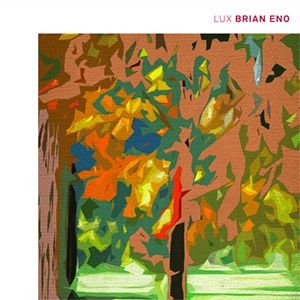Brian Eno Lux
For some, being a fan of Brian Eno is not always so easy. Across his […]

For some, being a fan of Brian Eno is not always so easy. Across his prolific and highly regarded career, the British musician, composer, producer, and artist has lent his unique touch and enlightened musical perspective to such an immense range of artistic endeavors that it is nearly impossible for anyone’s taste to align with them all. In the past two years, Eno has continued this legacy by taking up a residence of sorts with the legendary Warp label, releasing three records with the imprint prior to Lux which were—at least within the XLR8R realm—rather underwhelming efforts. Lux, however, bucks that trend. Formed from a piece originally conceived for the Great Gallery of the Palace of Venaria in Turin, Italy, the single, 75-minute composition is, conceptually speaking, Eno’s simplest work for Warp yet. That said, it’s also his most successful outing for the label thus far, as the combination of processed strings, guitar, and keys makes for an absolutely gorgeous listening experience.
In the liner notes which accompanied the formative Ambient 1: Music for Airports record in 1978, Eno set out to explain, and in some ways defend, his decision to pursue “ambient music” (particulary as opposed to Muzak), stating:
“Whereas the extant canned music companies proceed from the basis of regularizing environments by blanketing their acoustic and atmospheric idiosyncrasies, Ambient Music is intended to enhance these. Whereas conventional background music is produced by stripping away all sense of doubt and uncertainty (and thus all genuine interest) from the music, Ambient Music retains these qualities. And whereas their intention is to ‘brighten’ the environment by adding stimulus to it… Ambient Music is intended to induce calm and a space to think.”
On Lux, these principles appear to still be at the foundation of Eno’s ambient constructions, and when one considers the setting this music was originally intended for—an immaculate space where classic European architecture meets an abundance of natural light—it’s no wonder that a pristine combination of overlayed strings, hesitant guitar, and lush piano were chosen to reflect the elegant surroundings.
Although at times we may forget, it is still safe to say that Eno is nothing short of a master when it comes to the subtle and sophisticated art of crafting ambient music. Lux is just the latest documentation to support this claim; its gradual movement is tranquil but not boring, its sound intriguing but not commanding. The specifics and details of the work are largely unimportant to its experience; the composite of elements and the cluster of inviting tones they form are what make this somewhat challenging piece (it is, after all, one continuous, 75-minute idea) such an enjoyable listen. Whether the audience chooses to give the composition its full attention or simply uses Lux as an aid to any number of activities (it seems an appropriate soundtrack for moments of contemplation, creation, or even rest), the record accomplishes what Eno has proposed is ambient music’s main purpose: to heighten one’s sense of their surroundings while allowing their own narrative to fill the music with meaning and context.

